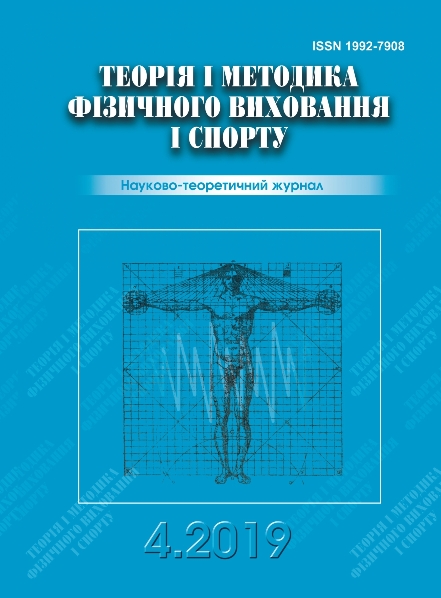THE IDENTIFICATION MODEL ON SWIMMING ATHLETES SKILL
DOI:
https://doi.org/10.32652/tmfvs.2019.4.30-35Ключові слова:
ідентифікація, навички плавання, талант, плаванняАнотація
Це дослідження має на меті розробити інструментальний тест і антропометричні, біомоторні ви-мірювання та навички плавання за допомогою моделі порівняння та програмного забезпечення. Інструмент використовується для виявлення майстерності або здібностей спортсменів з плавання. Вид використовуваних досліджень є кількісним, виходячи з моделі розробки. Зразок береться за допомогою методу квотного відбору проб, в якому беруть участь 60 осіб (30 чоловіків та 30 жінок) для першого тестування. Крім того, 120 осіб (60 чоловіків і 60 жінок) – для другого тестування, тому загальна кількість вибірки становить 180 осіб. Дані аналізуються за допомогою факторного та дискримінантного аналізу за допомогою програмного забезпечення SPSS. У результаті в першому періоді маємо 16 пунктів інструментального тесту для чоловіків і жінок. Результатом за другий період є використання факторного аналізу на суму 0,60 та отримано 16 інструментальних пунктів для чоловіків та 14 – для жінок. У результаті третього періоду з використанням факторного та дискримінантного аналізів отримано 12 інструментальних тестів для чоловіків та 12 – для жінок. Використовувалося програмне забезпечення FASTI (ідентифікація талантів плавання за Фахрурозі).
Посилання
Anshel MH, & Lidor R. (2012). Talent Detection Programs in Sport: The Questionable Use of Psychological Measures. Journal of Sport Behavior.
Bompa T, & Carrera M. (2015). Conditioning Young Athletes. In Modern Athlete & Coach.
Bond D, Goodson L, Oxford S, Nevill A, & Duncan M. (2015). The association between anthropometric variables, functional movement screen scores and 100 m freestyle swimming performance in youth swimmers. Sports, 3(1), 1–11.
Borms J. (1996). Early identification of athletic talent. Keynote Address to the International Pre-Olympic Scientific Congress.
Cooke C, Cobley S, Till K, & Wattie N. (2010). Searching for sporting excellence: talent identification and development. British Journal of Sports Medicine. https://doi.org/10.1136/bjsm.2010.078725.220
Dokumaci B, Aygün C, Doğan DD, & Atabek H Ç. (2017). Investigating the Anthropometric Variables and Bio-Motoric Properties in Male and Female Swimmers. International Journal of Sport Culture and Science, 5(4), 274–284.
Elferink-Gemser M, Visscher M, & Lemmink K. (2005). Today´s talented youth field hockey players, the stars of tomorrow? A study on talent development in field hockey.
Faber I, Nijhuis-Van der Sanden M. W. G. & Oosterveld F. G. J. (2012). A first step to an evidence-based talent identification program in the Netherlands; a research proposal. International Journal of Table Tennis Sciences 7, 15–18.
Gourgoulis V, Boli A, Aggeloussis N, Toubekis A, Antoniou P, Kasimatis P, … Mavromatis G. (2014). The effect of leg kick on sprint front crawl swimming. Journal of Sports Sciences, 32(3), 278–289.
Kondrič M. (2009). The expert system for orientation of children into table tennis in the Republic of Slovenia. Scientific Approach in Table Tennis and Tennis in Slovenia.
Lätt E, Jürimäe J, Mäestu J, Purge P, Rämson R, Haljaste K, … Jürimäe T. (2010). Physiological, biomechanical and anthropometrical predictors of sprint swimming performance in adolescent swimmers. Journal of Sports Science & Medicine, 9(3), 398.
Maksum A. (2012). Metodologi penelitian dalam olahraga. Surabaya: Unesa University Press.
Parsonage JR, Williams RS, Rainer P, McKeown I, & Williams MD. (2014). Assessment of conditioningspecific movement tasks and physical fitness measures in talent identified under 16-year-old rugby union players. Journal of Strength and Conditioning Research. https://doi.org/10.1519/JSC.0000000000000298
Régnier G, Salmela J, & Russell SJ. (1993). Talent detection and development in sport. Handbook of Research on Sport Psychology, 290–313.
Russell K. (1989). Athletic talent: from detection to perfection. Science Periodical on Research and Technology in Sport, 9(1), 1–6.
Stallman RK, Kjendlie PL, Haugen K, Melby M, de Faveri T, & Nesheim R. (2011). A Norwegian Model for Swimming Competency. Proceedings of the World Drowning Prevention Conference.
Van Den Bosch J, & De Cocq C. (2006). Sportief talent ontdekken. Acco.
Vrljic K, & Mallett CJ. (2008). Coaching knowledge in identifying football talent. International Journal of Coaching Science.
Williams AM, & Reilly T. (2000). Talent identification and development in soccer. Journal of Sports Sciences. https://doi.org/10.1080/02640410050120041
Zuniga J, Housh TJ, Mielke M, Hendrix CR, Camic CL, Johnson GO, … Schmidt RJ. (2011). Gender comparisons of anthropometric characteristics of young sprint swimmers. The Journal of Strength & Conditioning Research, 25(1), 103–108.
##submission.downloads##
Опубліковано
Номер
Розділ
Ліцензія
Авторське право (c) 2020 Теорія і методика фізичного виховання і спорту

Ця робота ліцензується відповідно до Creative Commons Attribution 4.0 International License.

